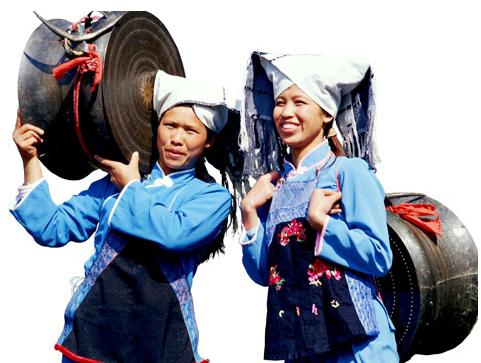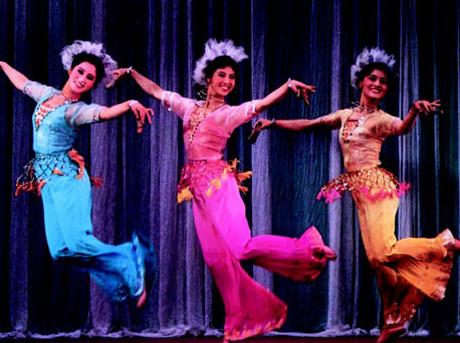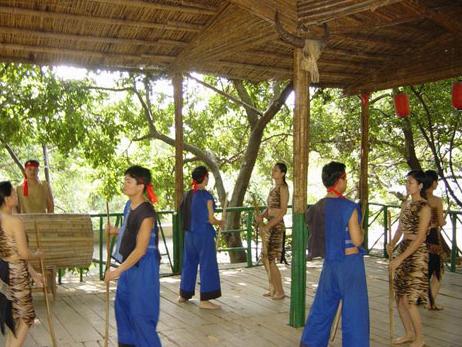
The Zhuang have a number of dances. Originating from different periods of their history, it is thought that the older ones have a ritual origin, imitating the movements of their shamans during their religious ceremonies.
In general their dances can be divided into four main types:
1. Religious dances
2. Labor dances
3. Animal dances
4. Love dances
1. Religious dances
1) Dance of the Bronze Drum
Possibly the most popular dance among the Zhuang, in most of their traditional festivals Zhuang villages hold competitions of drums, dancing at the same time the Dance of the Bronze Drum. For this dance they hang two drums from the two ends of a pole that two girls beat. They also hang a bigger drum in the middle of the pole, which is beaten by an old teacher. The old man marks the rhythm to which people will dance. At first some girls start to dance, but soon people cheer up and eventually all those participating in the festival join the dancing party around the bronze drum.
The bronze drum has a magical significance for some ethnic groups of southern China. During recent years large drums have been unearthed that were manufactured more than 2,000 years ago. The Kingdom of Dian, established near the present city of Kunming more than 2,000 years ago, was already famous for its bronze drums. They are appreciated for their sound that, according to local people, can expel bad spirits. Sometimes they were used as a kitchen bowl during important ceremonies. Every village considers its drums as their treasure.
Among the Zhuang and other peoples of the region there are a number of myths about these bronze drums. The long poem sung by some peoples of Yunnan "The kings of the bonze drum" portrays a community that arrives from distant lands, throughout whose long history the bronze drum becomes its main protector. Alleviating their material and spiritual sufferings, it communicates to them the will of the gods.
The Zhuang have a festival called the Festival of the Bronze Drums. It takes place on the 1st, 15th and 30th days of the first lunar month. The fundamental activity is the competition of bronze drums among the villages. It is considered an auspicious activity to begin the year with, as according to their tradition, the sound of the drums drives away the demons.
2) Dance of the Traverse Drum
It is a dance that is only carried out by the shigong or shaman in their ceremonies of homage to the gods. It receives its name because they dance with a small chest drum made of pottery or wood, with skin of goat or snake, hanging of their chest.
The dances carried out by the shigong imitate the activities of the gods, ascending to the sky or going down to the earth. For that reason they were divided in seven fundamental steps: ascent to the horse, walking the horse, small jump, great jump, stop, half turn and double turn.
3) Dance of the Shigong
It is another of the ritual dances that the shigong or shamans carry out during Zhuang religious ceremonies. It is specially used in the ritual of thanking to the gods, in those aimed to expel the bad spirits, and when asking for rain.
The shigong takes in the hand its sword, its stick and other ritual objects and he covers his face with a mask. The way they dance has for the Zhuang a premonitory sense. He usually takes with him some musical instrument, a small drum, a plane drum, or some cymbals. The masks vary according to the deity to which is intended that ceremony.
2. Labor dances
In their origin they possibly also had a religious component: Imitating the rituals asking the protection of the gods to their different activities. The most popular are:
1) Dance of Milling the Rice
The dancers, with a stick, imitate the typical movements of this activity.
2) Dance from the Pole to the Shoulder
In which the movements of the Zhuang transporting things with their characteristic poles are imitated.
3) Dance of Catching the Tea
Making the usual movements when picking tea leaves
4) Dance of Catching Shrimps
With the movements of fishing shrimps

3. Animal dances
Imitating the movements of different animals - They think that the person can take some of the qualities of the animal whose movements are imitated during the dance.
1) Turtledove's Dance
Turtledove’s dance is very common in the south of Yongning. Three men make of doves, dancing and singing. They imitate the doves moving the wings and picking the grain, they gurgle then happy for their luck. It is thought that this dance is also a form of propitiating a good crop, in which people can feed as the doves.
2) Lion's Dance
A dance transmitted by the Chinese, it was accepted with ardor by the Zhuang. Before 1949 each village had its teams of lion's dance. Every year took place competitions that involved thousands of people in Guangxi Province. The winners were called "Guangxi Lion Kings"

4. Love dances
Generally with sweet movements, they take place during the most important festivals, when the young meet. The habitual form of seduce the loved one.





